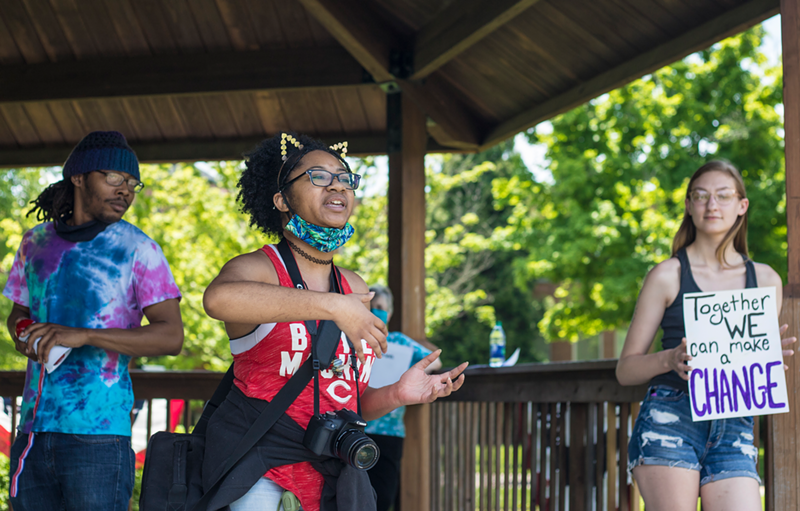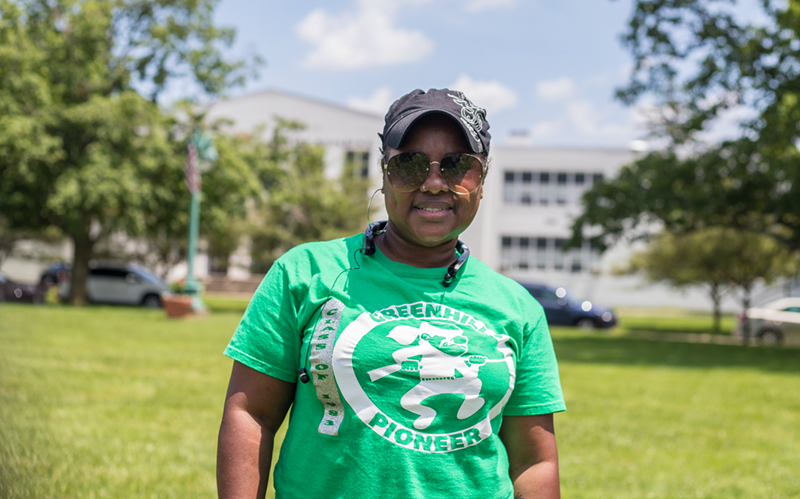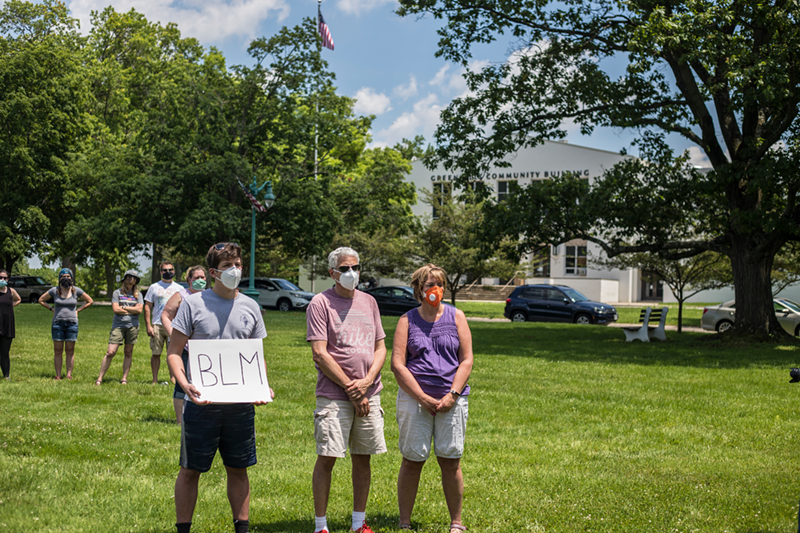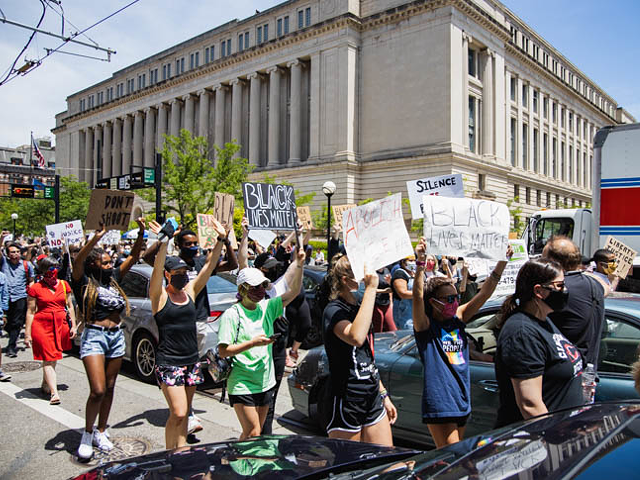
The grass is green on the commons and the Greenhills Community Building shines white in the sunlight. It’s a textbook early summer Friday in the quiet suburb just north of Cincinnati.
But June 5, 2020 is also unique.
Several dozen people, mostly but not all white, have put down their Black Lives Matter signs and taken a knee in that grass around the gazebo that sits before the community building. For nine minutes — one for every minute white Minneapolis Police Officer Derek Chauvin held his knee to the neck of George Floyd May 25 as Floyd, who was black, died — there is nothing but the chirping of birds and the sound of traffic many yards away on Winton Road.
It’s just nine minutes in the 81-year existence of this small American village of about 3,600 people. But they are a poignant nine minutes, given the town's history.
As protests over the deaths of Floyd, Louisville's Breonna Taylor and others have rolled through many large American cities, drawing crowds of thousands, they have also come — sometimes more slowly and quietly — to the nation's suburbs, including West Chester and Greenhills.
The federal government created Greenhills in the depths of the Great Depression during President Franklin Delano Roosevelt’s New Deal program. It was one of three small towns designed to provide ideal, somewhat communal living for poor and working class Americans suffering from the Depression and crowded, polluted conditions of cities like Cincinnati.
It was also expressly whites only.
Long after the federal government divested from the town following World War II, that segregated legacy continued. Though a few black students attended the village’s school district prior, the district drew up a voluntary plan to integrate its high school in 1979, 40 years after it was founded. But in 1984, the year after the first black students brought in under that plan graduated, only 23 of Greenhills’ 5,000 residents were black.

Lisa Leace was one of those students. She grew up in neighboring Forest Park. For her, the rally on the green was a revelation. Wearing her Greenhills High School pride gear, Leace climbs into the gazebo and takes a small bullhorn to praise both the organizers and attendees at the event — and pushes them to continue their work.
“Imagine my experience — black people, whom Greenhills was not used to seeing, sent to a school with white students," she says. "We were not welcome. This would have never happened in 1983.”
Greenhills has gotten more diverse in the years since Leace graduated — blacks account for about 13 percent of the village’s population today. But a reputation for racial tension and disparities linger among some in Greater Cincinnati, not helped by some unfortunate associations.
The last time Cincinnati saw massive protests over racial disparities in policing, they were sparked by the 2015 shooting of unarmed black motorist Sam DuBose by former University of Cincinnati Police Officer Ray Tensing, who got his start as a part-time officer with the Village of Greenhills Police Department.
Greenhills residents, however, take pains to stress that it is a welcoming community. Black-owned businesses occupy the town’s small business district. And like a lot of American suburbs, it continues to diversify.
Some openly acknowledge its painful history with race, but say they have hopes the town — and America as a whole — can transcend that history.
“This was a sundown town,” says Pat Andwan, who has lived in Greenhills for decades and once ran for mayor. “That meant blacks were not allowed in the town after sundown. I hope with the efforts of all the people here, their hearts and minds, things will change.”
Danielle Horsley of neighboring Woodlawn speaks to the crowd before the moment of silence. She’s one of four young, local organizers who put the rally together.
Horsley focuses on the fact that June 5 is Taylor’s birthday.
Horsley says she identifies with Taylor, who would be turning 27 this day had she not died after Louisville police her shot eight times during a no-knock raid on her apartment. Taylor was not armed, though her boyfriend fired one round as police pounded down their door. Officers were serving a warrant on a person who did not live there and turned out to already be in custody.
Like Taylor, Horsley is 26. Like Taylor, Horsley is black.
Three other organizers — Tahji Woods of neighboring Forest Park and Greenhills’ Nick Purdin and Susie Lutes — asked Horsley to come speak.
“I didn’t expect anyone to join us, but it turned into a great thing,” Purdin says. “I value these people because they’ve spoken some great words.”
Woods has both positive and negative associations with Greenhills, including some experiences with racism, he says.
“This was my roaming ground growing up,” he says. “I stayed in Forest Park but I was always over here meeting people at the pool. We used to meet up here and play football. I really did feel the need to mention the injustices that have happened in this community.”
Susie Lutes is the fourth member of the group that organized the event. Like Purdin, she grew up in Greenhills.
“I couldn’t ignore it,” she said of the protests happening across the country over racial disparities. “We had to bring it here to our town. We wanted to bring it to the smaller communities where it is easier to look away and not pay attention. People are just going to the pool and living like normal. We wanted to put it in peoples’ faces who aren’t paying attention.”
But the message this day on the sunny green is one of understanding, too. It is understandable to be overwhelmed about America’s racial tensions, organizers told the crowd. Everyone is still learning.
“It’s OK not to know,” Horsley tells the crowd mid-afternoon. “I understand that when tensions rise, it’s hard to listen. You feel attacked. You’re going to feel attacked — trust me, I know. But it’s about stepping out of that, removing yourself from that emotion. We have to be willing to learn from each other and teach each other. It’s OK to say ‘I have no idea what is going on, but I know this is not right.’ I will not judge you. I will support you, as long as there is genuine support for me.”

Those who come out to the event are receptive.
Greenhills-Winton Woods School District educator Gary Giblin has taught middle school just down the street from the rally location for two decades.
“We’re privileged to be here,” he tells organizers. “Thank you for stepping up here and speaking. You made me want to cry. I’m an old white guy… and I’m embarrassed. But I want to tell you that we’re learning. At a time when black lives don’t seem to matter, we need to say 'black lives matter.'"
As the rally progresses, Kim Suffoletta stands with her family on the green lawn watching. Her son Drew holds a white sign with three black letters — “BLM.”
“I know right from wrong,” Kim says. “And what I’ve been seeing is wrong. It’s time to stop sitting in the safety of my house and to come out and show my support.”
“To see people gather where I’ve lived and grown up, it’s really eye-opening,” Drew says. “It fills my heart to see people standing up for what is right. This is the least I can do is come out here and stand with them.”





